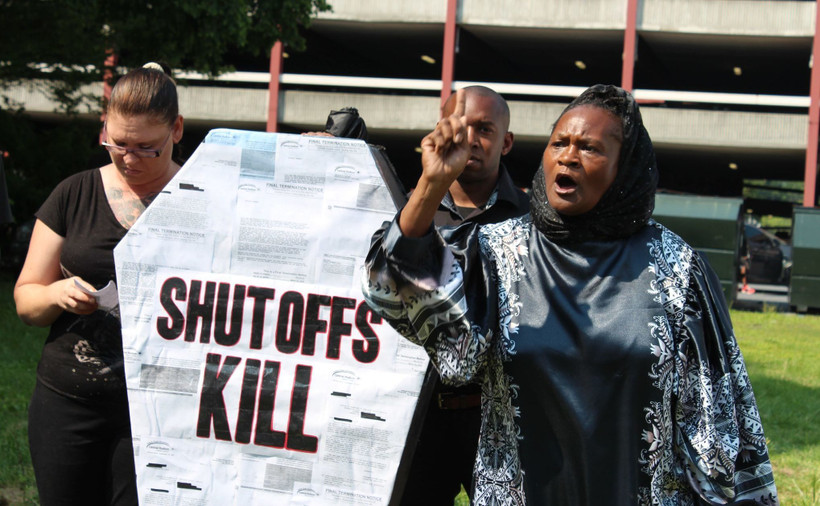As Utility Shutoff Freeze Nears End, New Yorkers in Debt Fear Shutoffs
Millions of New Yorkers are behind on their utility bills, and advocates say the state is doing a poor job distributing federal assistance.

In just under a month, an official freeze on service disconnections for New Yorkers behind on their utility bills will sunset, ending one of the state’s key pandemic protections. The date: Dec. 21, the first day of winter.
State policy will still bar some utilities from shutting off residential service for unpaid bills around Christmas and New Year’s Day and under various other circumstances. But with millions of people facing massive levels of utility debt in the aftermath of COVID-19 and government aid slow to get out, experts worry New York will see a wave of shutoffs starting next spring.
“Come May or April, there could be a landslide if nothing is done in the budget,” said Bill Ferris, a state lobbyist for AARP, the powerful interest group for older people. “Some utilities absolutely terminate people in the winter, but in our research we tend to see them right after the heating season. That’s the fear.”
Meanwhile, utility debts continue to mount. The Public Utility Law Project (PULP), an Albany-based consumer advocacy nonprofit, provided New York Focus with a preliminary analysis of statewide data that found more than 1.2 million residential gas and electric accounts with almost $1.7 billion in arrears as of September. This represented a 119% increase in the total amount owed since February 2020, well above previous peaks in the years following the Great Recession.
Beyond energy, PULP also estimates up to $1 billion or more each in telephone, internet, and residential water arrears, as well as a potentially large amount in cable TV arrears. The actual totals are obscured by a lack of disclosure rules for non-energy utilities, the group said.
New York’s $2.7 billion emergency rent relief program was supposed to help tenants pay off their gas and electric debts from the pandemic, but little if any utility assistance appears to have been distributed, suggesting the state prioritized the rental assistance as estimates showed one in five renters were behind on rent. That program is now low on funds and closed to most new applications, though New York has requested almost $1 billion more in federal aid. Other utility relief programs exist, but they aren’t widely known and have cumbersome eligibility requirements.
“If this many households are going to be forced to divert money to paying off arrears in an unplanned, unreasonable way, they won’t be able to spend money on food, medicine,” and other essentials, said Richard Berkley, PULP’s executive director. “And that’s on top of the rent problem and the mortgage arrears problem.”
Pre-Pandemic Shutoffs Were Common
Even before COVID-19, New Yorkers had heaps of utility debt. Energy giant Consolidated Edison, better known as Con Ed, alone recorded more than 316,000 residential accounts with $335 million in arrears as of December 2019, according to New York Focus’ review of data collected by the New York Public Service Commission (PSC), the state utility regulator.
That year, Con Ed terminated nearly 65,000 residential accounts with more than $102 million in debt. More than 55,000 were reconnected, but the data doesn’t show how long they were without service. (Con Ed didn’t provide an average shutoff length in response to questions from New York Focus.)
Experts say long-term trends, such as deregulation and overcharging by third-party suppliers, have increased energy bills and driven up arrears and shutoffs. In 2016, the PSC adopted a policy setting 6% of household income as the maximum low-income New Yorkers should spend on energy, but the goal remains elusive: 460,000 low-income families in New York City paid more than that as of 2017, the mayor’s office found.
When the pandemic hit, the arrears crisis worsened as hundreds of thousands of New Yorkers lost work amid government-ordered shutdowns. Initially, at the state’s urging, major energy and water utilities suspended shutoffs and rate hikes. But without broad safeguards in place, some residents saw their internet — crucial for getting pandemic updates and communicating with loved ones, employers, and schools — cut off for nonpayment, despite a March 2020 national pledge by hundreds of telecommunications providers to “keep Americans connected.” Others were already living without utilities.
“People went into the pandemic without water, and people remained without water during the pandemic,” said Steve Halpern, an attorney at the Western New York Law Center in Buffalo. “Many of these folks are living in a state of marginality and limbo that’s hard for most of us to appreciate: no cell phones, abandoned homes that wouldn’t meet habitability standards.”
In May 2020, New York lawmakers passed a statewide ban on utility shutoffs, though cable TV, cell phone, and internet service were excluded. Then-Gov. Andrew Cuomo signed it into law three weeks later, making New York the first state to implement such a ban legislatively and drawing praise from advocates.
The moratorium expired March 31, 2021. That same day, the legislature passed a second moratorium, which included cable and broadband services and mandated that utilities offer customers deferred payment agreements without late fees, penalties, or down payments. Cuomo, who was under fire for sexual harassment allegations, didn’t enact it until mid-May.
This law established a “grace period” barring shutoffs for 180 days after New York’s COVID-19 emergency ended, but only for customers who “self-certified” to their utility that the pandemic impacted them financially. The law also required utilities to notify their customers about the new protections; however, advocates say compliance among the state’s more than 1,500 utilities — most of them public water providers — has been spotty at best. (Some utilities dispute this.)
On June 24, with improving coronavirus numbers and vaccination rates, Cuomo ended the state of emergency. The clock for the grace period started ticking.
Residents Get Termination Notices — But Not Much Help
After losing work in academia and having to care for a sick relative, Upper West Side resident Adrienne was nearly $750 behind on her Con Ed bills when she sought utility relief through New York’s Emergency Rental Assistance Program (ERAP) several months ago, she told New York Focus. She said her rent relief application was approved and paid out (albeit less than requested) in October, but without the utility relief.
“I thought Con Ed would get their money once it went through,” said Adrienne, who asked to be identified only by her first name for privacy reasons. When she called the ERAP customer service line, she said a representative told her the program hadn’t distributed any utility assistance.
Adrienne added that she avoided a payment plan with Con Ed because she was still hoping to receive the utility relief, even as Dec. 21 — the end of the shutoff grace period — approached. “What happens after that, if ERAP doesn’t send the money?” she said. “It’s my only path right now. But I don’t think Con Ed knows I’ve even applied.” (The company said it “would need to discuss this with the individual customer to fully understand the circumstances,” and that it hasn’t received information from the state about who applied for ERAP.)
As of Nov. 19, New York’s Office of Temporary and Disability Assistance (OTDA), which is running ERAP, had received more than 77,000 utility assistance requests, compared to 286,000 rental assistance requests, according to data from the agency. But it hasn’t publicized approval and payment figures for ERAP utility aid, which was designed to cover up to a year of gas and electric arrears, like it’s done for rental aid, and declined to provide these numbers to New York Focus. (Between January and June 2021, ERAP grantees made more than 200,000 utility arrears payments nationwide, the White House has said.)
In recent interviews with nonprofits helping people apply for the program, open since June, staff said they hadn’t heard of applicants’ utility arrears being resolved.
Kevin Quinn, a managing attorney at Buffalo’s Center for Elder Law & Justice, said although most of his organization’s ERAP clients requested utility relief, none came through. “We are seeing tenants approved for the rent but have not seen any checks cut to the utility providers,” he told New York Focus, noting some people owe up to $2,000 in utility bills since March 2020.
The program’s funding is currently running out. Applications closed for most New Yorkers Nov. 14, two days after Gov. Kathy Hochul announced she was seeking an extra $996 million for ERAP from the U.S. Treasury.
New York does offer some utility relief through other programs. The Hochul administration promoted $373 million in federal heating aid for low- and middle-income residents this fall through the Home Energy Assistance Program (HEAP), which opened in October. To qualify, a family of four must make less than $63,000 a year and provide various documents, or be enrolled in state cash or food assistance programs. This year, $150 million in supplemental HEAP benefits is also available for gas and electric arrears, via one-time payments up to $10,000.
But it’s unclear how much money has been disbursed so far. OTDA only confirmed “obligations” to utilities as of Nov. 5: $158 million in regular benefits for 523,000 households and $78 million in supplements for 50,000 households. And as New York Focus recently revealed, no money had gone out from a new $70 million water relief program for low-income residents as of last month. Advocates say more funding and better program management are needed to meet the scale of the current crisis.
In a statement, OTDA said it anticipates assisting about 125,000 households with pandemic utility arrears through HEAP and ERAP. “Combined, these programs will help thousands of low-income households make ends meet and avoid the grim prospect of utility disconnection when the statewide moratorium on shutoffs is lifted this winter,” said Justin Mason, a spokesperson for the agency.
More aid will likely open up in the coming weeks. Emergency HEAP benefits are set to launch in January, and last Thursday, Hochul said the Treasury had approved New York’s plan for a $539 million Homeowner Assistance Fund (HAF), which is partly designed to cover utility arrears. Still, the draft plan says applicants for utility relief will be required to “first secure any non-[New York State] HAF assistance that is available.”
In the meantime, many New Yorkers with utility arrears are receiving final termination notices for unpaid bills. Con Ed reported issuing more than 115,000 such notices to residential accounts with $122 million in arrears in September, though no terminations were carried out. More than 88,000 accounts were on deferred payment agreements at the end of that month, up 15% from a year before.
Jamie McShane, a spokesperson for Con Ed, told New York Focus the company is sending disconnect notices to customers in its low-income discount program so they can use those notices to obtain emergency public assistance, as required for certain programs. He added that Con Ed is “not quick to turn customers off in normal times and stopped turnoffs completely during the pandemic,” and has seen an overall decrease in deferred payment agreements since March 2020.
Asked about Con Ed’s plans regarding shutoffs this winter, McShane referred to a page on the company’s website explaining pandemic protections and government assistance. “Our focus is on continuing to work with customers to get on payment plans and stay current,” he said. “We encourage customers who are having problems paying their bills to call us.” (On Nov. 4, the investor-owned utility recorded a profit of $1.12 billion, or $3.23 a share, for the first nine months of 2021, up from $1.06 billion, or $3.17 a share, for those of 2020.)
Jonathan Bix, the executive director of For the Many, a grassroots group based in the Hudson Valley that supports expanding public renewables, said narrow, means-tested benefits won’t solve the arrears crisis. “There’s some parallels between the eviction situation and the utility situation in that the moratoriums have been good, but we haven’t seen the kind of full debt forgiveness we need to make up the huge gap in people being able to afford their utilities and rents during the pandemic,” he said.
“It’s just delaying when people will be evicted or have their power shut off."
“Spirited Discussion” Over Clearing The Utility Debt
Negotiations over how to address New York’s energy arrears are underway in state regulatory proceedings. Berkley, of PULP, which is party to the proceedings along with AARP, told New York Focus that federal money as well as contributions from utility shareholders and the state should help cover the debt.
“As you can imagine, there’s some spirited discussion over the amounts from each piece of that pie,” he said.
In a filing with state regulators last month, New York’s biggest energy utilities said they oppose extending the shutoff grace period beyond Dec. 21 or waiving late fees associated with payment plans. The group, which includes Con Ed, Central Hudson, National Grid, New York State Electric & Gas, supported fully implementing ERAP and HEAP so as to “forgive substantial portions of existing utility arrears with federal funding, rather than funding from shareholders or utility ratepayers.”
PULP, AARP, and 10 other organizations, meanwhile, have called for Hochul to allocate more than $1 billion in federal funds toward low- and moderate-income New Yorkers’ energy arrears and, if necessary, to extend the moratorium on shutoffs until June. They also urged legislation encouraging debt forgiveness by private water, telephone, and broadband providers.
Asked about the letter and Hochul’s plans for addressing utility debt in the state, Jim Urso, a spokesperson for the governor, told New York Focus in a statement: “Governor Hochul remains committed to helping New Yorkers still struggling from the financial devastation of the pandemic, and we will continue to work closely with the utility companies and our partners in the legislature to ensure that those in need get the support and assistance they deserve.”




